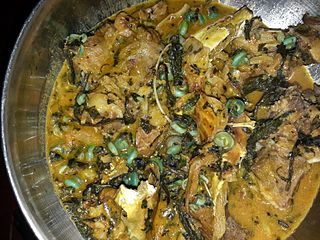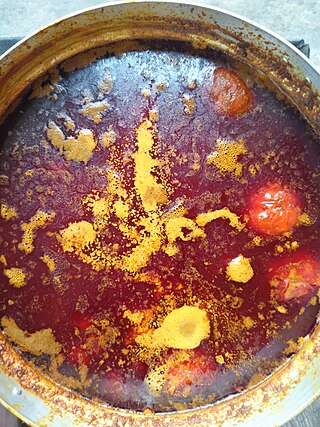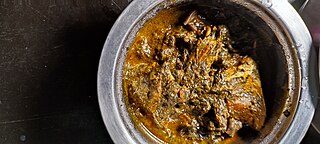Ofe Owerri is an Igbo delicacy in the South-Eastern part of Nigeria. The soup is made with snails, beef,assorted meat and fishes. [1] [2]
Ofe Owerri is an Igbo delicacy in the South-Eastern part of Nigeria. The soup is made with snails, beef,assorted meat and fishes. [1] [2]
As the name implies the soup is popular amongst the people living in the capital of imo state, Owerri. [3]
The soup is one of the most expensive Igbo soups which is why is nicknamed 'Jewel of South East'. [2] [4]
Varieties of vegetables such as okazi and uziza leaf are used in preparing it. Ugu can serve as an alternative to uziza when it is not readily available. Other ingredients include different type of fish and meats and crayfish. Ofe Owerri is cooked with palm oil and achi[ clarification needed ] is used to thicken the soup. [5]
Ofe Owerri can be eaten with semolina, fufu, pounded yam and Eba [3] [5]

Owerri is the capital city of Imo State in Nigeria, set in the heart of Igboland. It is also the state's largest city, followed by Orlu, Okigwe and Ohaji/Egbema. Owerri consists of three Local Government Areas including Owerri Municipal, Owerri North and Owerri West, it has an estimated population of about 1,401,873 as of 2016 and is approximately 100 square kilometres (40 sq mi) in area. Owerri is bordered by the Otamiri River to the east and the Nworie River to the south. The Owerri Slogan is Heartland.

Ẹ̀bà (Yoruba) also known as Ebe or Pinon' is a staple swallow from Togo and Benin, also eaten in the West African sub-region and other African countries. The term èbà originates from Yoruba. It is also called utara by the Igbo people of southeast Nigeria. It is a cooked starchy vegetable food made from dried grated cassava (manioc) flour commonly known as garri all across West Africa. It is often eaten with rich soups and stews, with beef, stockfish or mutton. The dish is often described as having a slightly sour, sharp taste.

Ogbono soup is a Nigerian dish made with ground dry ogbono seeds. Ogbono seeds are originated and were first grown in Southern Nigeria with considerable local variation. According to research by Chris Chinaka and J.C. Obiefuna, Ogbono is an indigenous forest tree associated with plants classified as 'non-timber forest products. It goes by various indigenous names among Nigerians. Common use of the word “ogbono” in general Nigerian parlance stems from the Igbo name for the word. Among the Nupe, it is called 'pekpeara', 'ogwi' in Bini, 'uyo' in Efik, and 'oro' or ‘apon’ in Yoruba. Although ogbono and ugiri, the Igbo name for bush-mango, are very similar indeed and often regarded as equivalents, there is technically a distinction.

Draw soup is the name of soups from the southeastern and southwestern parts of Nigeria that are made from okra, ogbono(Irvingia gabonensis), or ewedu leaves (jute). The name derives from the thick viscosity characteristic of the broth as it draws out of the bowl when eaten either with a spoon or, more characteristically, by dipping a small piece of solid (fufu) into it. It can be served with numerous Nigerian fufu meals, including eba (garri) and pounded yam. Ewedu can be used to make a Yoruba soup that is traditionally served with amala.

Nigerian cuisine consists of dishes or food items from the hundreds of Native African ethnic groups that comprise Nigeria. Like other West African cuisines, it uses spices and herbs with palm or groundnut oil to create deeply flavored sauces and soups.

Igbo cuisine is the various foods of the Igbo people of southeastern Nigeria.

Peanut soup or groundnut soup is a soup made from peanuts, often with various other ingredients. It is a staple African cuisine but is also eaten in East Asia (Taiwan), the United States and other areas around the world. It is also common in some regions, such as Argentina northwest, Bolivia and Peru, where it can sometimes be served with bone meat and hollow short pasta or fries. In Ghana it is often eaten with fufu, omo tuo and banku often very spicy. Groundnut soup is also a native soup of the Benin (Edo) people in Nigeria and it is often eaten with pounded yam. Some of the essential ingredients used in making it are Piper guineense and Vernonia amygdalina.

Palm nut soup or banga is a soup made from palm fruit common in the Cameroonian, Ghanaian, Nigerian, Democratic Republic of Congo and Ivorian communities. The soup is made from a palm cream or palm nut base with stewed marinated meats, smoked dried fish, and aromatics. It is often eaten with starch, fufu, omotuo, banku, fonio, or rice. The use of the palm fruit in cooking is significant in Ivorian, Cameronian, Nigerian, Ghanaian, Liberian and other West and Central African cuisine.

Okra or Okro soup is prepared using the edible green seed pods of the okra flowering plant as a primary ingredient. Other vegetables can be added to the soup as well, such as ewedu, kerenkere, or Ugu leaf. Depending on the specific variant being prepared, okra soup can have a clear broth or be deep green in colour, much like the okra plant itself. Okra can have a slippery or "slimy" mouthfeel. The edible green seed pods can also be used in other stews and soups, such as the American dish gumbo.

Goat meat pepper soup, also referred to as nwo-nwo, ngwo-ngwo, and goat pepper soup, is a soup in Nigeria. Goat meat is used as a primary ingredient, and some versions may use crayfish. For variations boiled yams, potatoes, or plantains may be added. Versions of the soup may be spicy and hot. The soup is always served hot and is made with a blend of different spices which gives an intense spiciness and flavor to the soup. The dish has been described as being the most popular out of all the Nigerian pepper soups. It is a light soup that is often prepared without the use of oil, and may also be drunk in the style of a beverage. Owing to the ‘light’ texture of the soup, it is typically eaten alone but it can be accompanied by a side-dish known as agidi. White rice is also a common side-dish served with goat meat pepper soup. It has been described as pairing well with palm wine and beer.

Nsala soup is also known as white soup but it is widely called Ofe Nsala by the Igbo people. Ofe Nsala is known as white soup because palm oil is not used for the preparation, unlike other traditional soups. It is made with small pieces of yam or Cocoyam with utazi leaves. The soup is a delicacy that originates from the eastern part of Nigeria. A major ingredient is the catfish, which gives the soup a unique taste. Nsala is similar to Afia Efere, which is common among the Efik ethnic group.

Atama soup or Amme-Eddi is also called Banga Soup in pidgin English(Nigerian English) It is a kind of palm-fruit vegetable soup that originates from the Efik people of Cross River state and Urhobo people of Delta State in South South Nigeria. It’s a popularly food among the Delta, Cross River and Akwa Ibom State People of Nigeria. The Urhobo people of Delta state called it Amme-edi or Banga soup. The soup is made from palm fruit-pulp that is derived from palm fruit; the extracted palm-pulp is base primary ingredient for the soup. Atama or Amme-edi(Banga) soup is thick and dark brown in color. It’s normally prepared with choice of protein like fresh meat or dry meat(mostly bush meat), dry fish, fresh fish and sometimes shrimp(dry or fresh), periwinkle as added proteins for more enhanced flavor. Ingredients: primary ingredients are fresh palm-pulp sourced from palm fruit, salt and pepper and secondary ingredients which are decided based on preference of the cooker are onions, salt, pepper(different kinds of pepper are preferences) and different kinds of spices could be added depending on the cooker preferred or desired taste or flavor. This soup could be styled into different flavors depending on cooking preferences. Every added ingredient could drastically change the taste of the food.

Ofe Oha is a soup mostly eaten in the south eastern part of Nigeria.
Ofe achara is an Igbo soup made mainly from Achara and mgbam. Ofe In the language refers to soup.
Edo black soup also known as omoebe is a Nigerian soup made mainly from three leaves namely scent leaf, uziza leaf and bitter leaf. Other ingredients include beef, onion, crayfish, pepper and palm oil.
Fio Fio is a Nigerian food peculiar to the South-Eastern part, the soup is made guinea pea and cocoyam as the major ingredients.

Afia Efere is a Nigerian soup popular amongst the Efik tribe, the soup is also known as white soup due to absence of palm oil in it.
Otong soup is a Nigerian soup made in the South Eastern region, it is popular among the Efik tribe of the cross River state. Similar soup are 'Ila alasepo' of Yoruba and 'okwuru' of the Igbo tribe.
Yam pepper soup is a Nigerian dish made using soft white puna yam. It is necessary for the yam to be soft.
Mahogany Seed Soup (Ofe Akparata) is a soup made from Mahogany seed traditional known as Akparata among the Igbo tribe. The soup originates from the Eastern part of Nigeria and it is a favourite dish among the Enugu indigenes. The Mahogany seed is widely used as a thickener used in soups and other dishes, besides using it as a thickener it can also be used in making the sauce used in the preparation of Cowleg or Goatleg Nkwobi and Abacha.